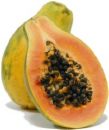Origin: The papaya is believed to be native to southern Mexico
and neighboring Central America. It is now present in every tropical
and subtropical country.
Adaptation: Papayas have exacting climate requirements for
vigorous growth and fruit production. They must have warmth
throughout the year and will be damaged by light frosts. Brief
exposure to 32° F is damaging and prolonged cold without overhead
sprinkling will kill the plants. Cold, wet soil is almost always
lethal. Cool temperatures will also alter fruit flavor. Papayas make
excellent container and greenhouse specimens where soil moisture and
temperature can be moderated.
Growth Habit: The papaya is a short-lived, fast-growing, woody,
large herb to 10 or 12 feet in height. It generally branches only
when injured. All parts contain latex. The hollow green or deep purple
trunk is straight and cylindrical with prominent leaf scars. Its
diameter may be from 2 or 3 inches to over a foot at the base.
Fruit:There are two types of papayas, Hawaiian and Mexican.
The Hawaiian varieties are the papayas commonly found in supermarkets.
These pear-shaped fruit generally weigh about 1 pound and have yellow
skin when ripe. The flesh is bright orange or pinkish, depending on
variety, with small black seeds clustered in the center. Hawaiian
papayas are easier to harvest because the plants seldom grow taller
than 8 feet. Mexican papayas are much larger the the Hawaiian types
and may weigh up to 10 pounds and be more than 15 inches long. The
flesh may be yellow, orange or pink. The flavor is less intense than
that the Hawaiian papaya but still is delicious and extremely
enjoyable. They are slightly easier to grow than Hawaiian papayas.
A properly ripened papaya is juicy, sweetish and somewhat like a
cantaloupe in flavor, although musky in some types. The fruit (and
leaves) contain papain which helps digestion and is used to tenderize
meat. The edible seeds have a spicy flavor somewhat reminiscent of
black pepper.



